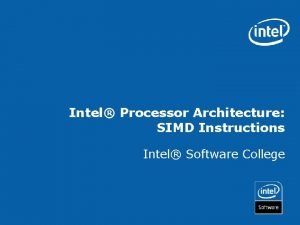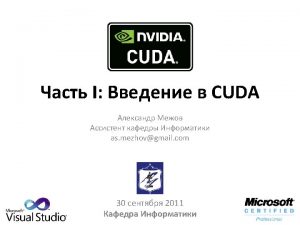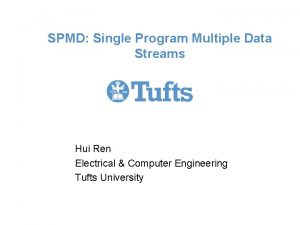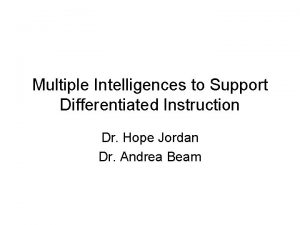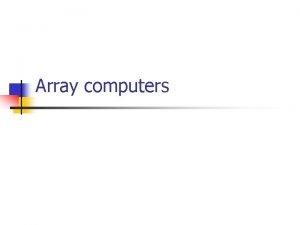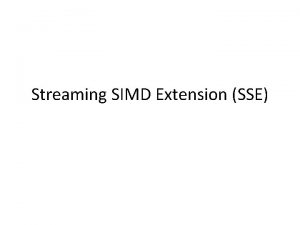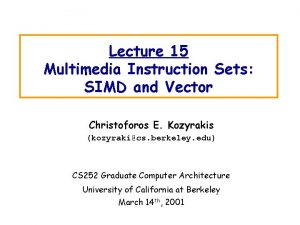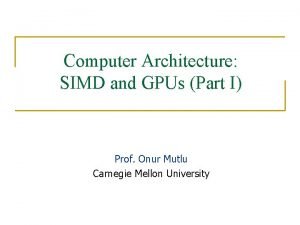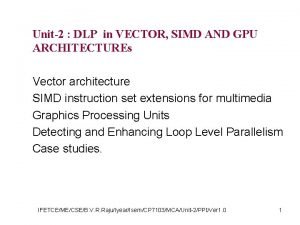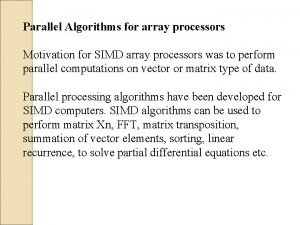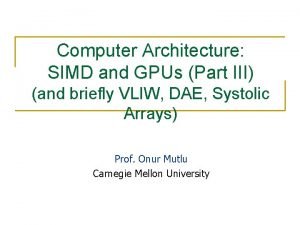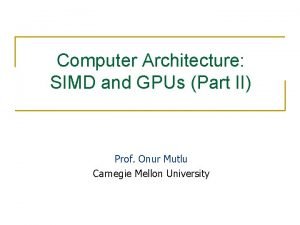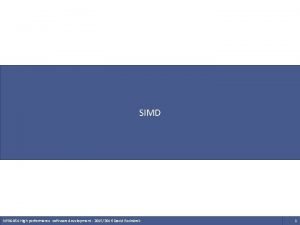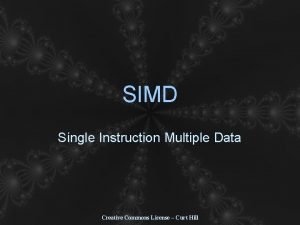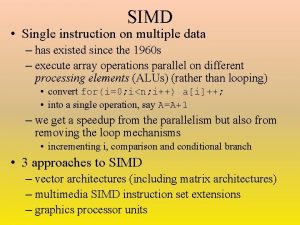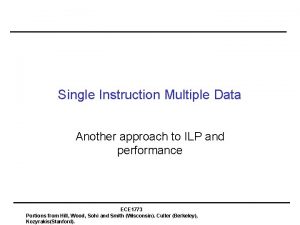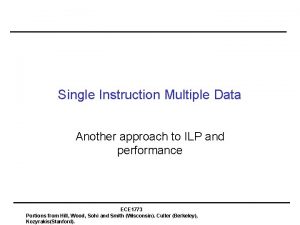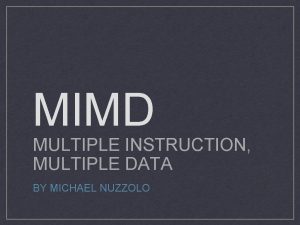SIMD Single Instruction Multiple Data SIMD Motivation Contd



![Sequential Execution Model / SISD int a[N]; // N is large for (i =0; Sequential Execution Model / SISD int a[N]; // N is large for (i =0;](https://slidetodoc.com/presentation_image_h2/4fd9b8c37d1728e10953aac019a202f5/image-4.jpg)
![Data Parallel Execution Model / SIMD int a[N]; // N is large for all Data Parallel Execution Model / SIMD int a[N]; // N is large for all](https://slidetodoc.com/presentation_image_h2/4fd9b8c37d1728e10953aac019a202f5/image-5.jpg)














![a[i] = a[i] + 10 b[i] = b[i] * a[i] c[i] = c[i] + a[i] = a[i] + 10 b[i] = b[i] * a[i] c[i] = c[i] +](https://slidetodoc.com/presentation_image_h2/4fd9b8c37d1728e10953aac019a202f5/image-20.jpg)


![Vector Code Example • • Y[0: 63] = Y[0: 63] + a * X[0: Vector Code Example • • Y[0: 63] = Y[0: 63] + a * X[0:](https://slidetodoc.com/presentation_image_h2/4fd9b8c37d1728e10953aac019a202f5/image-23.jpg)

- Slides: 24

SIMD • Single Instruction Multiple Data

SIMD: Motivation Contd. • Recall: – Part of architecture is understanding application needs • Many Apps: – for i = 0 to infinity • a(i) = b(i) + c • Same operation over many tuples of data • Mostly independent across iterations Portions from Hill, Wood, Sohi and Smith (Wisconsin). Culler (Berkeley), Kozyrakis(Stanford).

Some things are naturally parallel
![Sequential Execution Model SISD int aN N is large for i 0 Sequential Execution Model / SISD int a[N]; // N is large for (i =0;](https://slidetodoc.com/presentation_image_h2/4fd9b8c37d1728e10953aac019a202f5/image-4.jpg)
Sequential Execution Model / SISD int a[N]; // N is large for (i =0; i < N; i++) time a[i] = a[i] * fade; Flow of control / Thread One instruction at the time Optimizations possible at the machine level
![Data Parallel Execution Model SIMD int aN N is large for all Data Parallel Execution Model / SIMD int a[N]; // N is large for all](https://slidetodoc.com/presentation_image_h2/4fd9b8c37d1728e10953aac019a202f5/image-5.jpg)
Data Parallel Execution Model / SIMD int a[N]; // N is large for all elements do in parallel time a[i] = a[i] * fade; This has been tried before: ILLIAC III, UIUC, 1966 http: //ieeexplore. ieee. org/xpls/abs_all. jsp? arnumber=4038028&tag=1 http: //ed-thelen. org/comp-hist/vs-illiac-iv. html

SIMD Processing SCALAR (1 operation) SIMD (N operations) r 2 r 2 r 2 r 1 r 1 r 1 + + + r 3 r 3 r 3 r 2 r 1 add r 3, r 1, r 2

TIME C 1 fetch C 2 C 3 C 4 C 5 decode rf exec wb wb exec wb C 6 C 7 C 8 C 9 C 10 fetch decode rf exec wb wb exec wb

TIME C 1 fetch C 2 C 3 C 4 C 5 decode rf exec wb wb exec rf wb exec fetch decode exec rf C 6 C 7 wb wb wb exec wb C 8 C 9 C 10

SIMD Architecture CU μCU regs PE PE PE MEM MEM • Replicate Datapath, not the control • All PEs work in tandem • CU orchestrates operations ALU

Multimedia extensions SIMD in “modern” CPUs

MMX: Basics • Multimedia applications are becoming popular • Are current ISAs a good match for them? • Methodology: – Consider a number of “typical” applications – Can we do better? – Cost vs. performance vs. utility tradeoffs • Net Result: Intel’s MMX • Can also be viewed as an attempt to maintain market share – If people are going to use these kind of applications we better support them

Multimedia Applications • Most multimedia apps have lots of parallelism: – for I = here to infinity • out[I] = in_a[I] * in_b[I] – At runtime: • out[0] = in_a[0] * in_b[0] • out[1] = in_a[1] * in_b[1] • out[2] = in_a[2] * in_b[2] • out[3] = in_a[3] * in_b[3] • …. . • Also, work on short integers: – in_a[i] is 0 to 256 for example (color) – or, 0 to 64 k (16 -bit audio)

Observations • 32 -bit registers are wasted – only using part of them and we know – ALUs underutilized and we know • Instruction specification is inefficient – even though we know that a lot of the same operations will be performed still we have to specify each of the individually – Instruction bandwidth – Discovering Parallelism – Memory Ports? • Could read four elements of an array with one 32 -bit load • Same for stores • The hardware will have a hard time discovering this – Coalescing and dependences

MMX Contd. • Can do better than traditional ISA – new data types – new instructions • Pack data in 64 -bit words – bytes – “words” (16 bits) – “double words” (32 bits) • Operate on packed data like short vectors – SIMD – First used in Livermore S-1 (> 20 years)

MMX: Example Up to 8 operations (64 bit) go in parallel w Potential improvement: 8 x w In practice less but still good w. Besides another reason to think your machine wis obsolete ECE 1773 Portions from Hill, Wood, Sohi and Smith (Wisconsin). Culler

Data Types



Vector Processors SCALAR (1 operation) r 2 r 1 VECTOR (N operations) v 1 v 2 + + r 3 v 3 add r 3, r 1, r 2 vector length vadd. vv v 3, v 1, v 2 • Scalar processors operate on single numbers (scalars) • Vector processors operate on vectors of numbers – Linear sequences of numbers • Does not say that they have to be done in parallel From. Christos Kozyrakis, Stanford
![ai ai 10 bi bi ai ci ci a[i] = a[i] + 10 b[i] = b[i] * a[i] c[i] = c[i] +](https://slidetodoc.com/presentation_image_h2/4fd9b8c37d1728e10953aac019a202f5/image-20.jpg)
a[i] = a[i] + 10 b[i] = b[i] * a[i] c[i] = c[i] + b[i] TIME C 1 fetch C 2 C 3 C 4 C 5 C 6 decode rf exec rf wb exec wb C 7 C 8 decode rf exec rf wb exec decode rf exec rf wb b[i] = b[i] * a[i] wb rf fetch C 10 a[i] = a[i] + 10 rf fetch C 9 wb exec wb c[i] = c[i] + b[i] rf exec wb

Example of Simple Vector Processor

What’s in a Vector Processor • A scalar processor (e. g. , a MIPS processor) – Scalar register file (32 registers) – Scalar functional units (arithmetic, load/store, etc) • A vector register file (a 2 D register array) – Each register is an array of elements • E. g. , 32 registers with 32 64 -bit elements per register – MVL = maximum vector length = max # of elements per register • A set for vector functional units – Integer, FP, load/store, etc – Some times vector and scalar units are combined (share ALUs)
![Vector Code Example Y0 63 Y0 63 a X0 Vector Code Example • • Y[0: 63] = Y[0: 63] + a * X[0:](https://slidetodoc.com/presentation_image_h2/4fd9b8c37d1728e10953aac019a202f5/image-23.jpg)
Vector Code Example • • Y[0: 63] = Y[0: 63] + a * X[0: 63] LD R 0, a VLD V 1, 0(Rx) V 1 = X[] VLD V 2, 0(Ry) V 2 = Y[] VMUL. SV V 3, R 0, V 1 V 3 = X[]*a VADD. VV V 4, V 2, V 3 V 4 = Y[]+V 3 VST V 4, 0(Ry) store in Y[]

Modern Multimedia Instruction Extensions • AVX Vector extension • 256 bit registers – 8 32 b floating-point – 4 64 b floating-point • Many new instructions
 Parceloo
Parceloo Multiple instruction multiple data
Multiple instruction multiple data Multiple instruction single data
Multiple instruction single data Dataxin
Dataxin Intel simd instructions
Intel simd instructions Single instruction multiple thread
Single instruction multiple thread Single program, multiple data
Single program, multiple data Differentiated instruction vs individualized instruction
Differentiated instruction vs individualized instruction Site:slidetodoc.com
Site:slidetodoc.com Multiple intelligences and differentiated instruction
Multiple intelligences and differentiated instruction Single instruction stream
Single instruction stream Multiple baseline vs multiple probe design
Multiple baseline vs multiple probe design Sse simd
Sse simd Simd units
Simd units Simd extensions
Simd extensions Simd in computer architecture
Simd in computer architecture Simd architecture ppt
Simd architecture ppt Simd.scot
Simd.scot Simd parallel algorithms
Simd parallel algorithms Systolic array vs simd
Systolic array vs simd Simd vs gpu
Simd vs gpu Flynns taxonomy
Flynns taxonomy Intel simd
Intel simd Single row functions in sql
Single row functions in sql Single user and multi user operating system
Single user and multi user operating system




